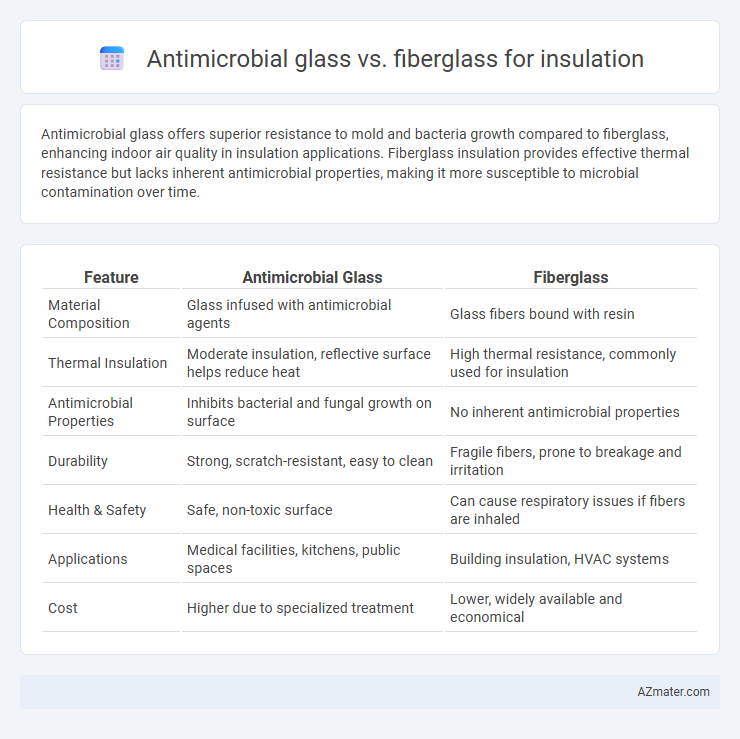Antimicrobial glass offers superior resistance to mold and bacteria growth compared to fiberglass, enhancing indoor air quality in insulation applications. Fiberglass insulation provides effective thermal resistance but lacks inherent antimicrobial properties, making it more susceptible to microbial contamination over time.
Table of Comparison
| Feature | Antimicrobial Glass | Fiberglass |
|---|---|---|
| Material Composition | Glass infused with antimicrobial agents | Glass fibers bound with resin |
| Thermal Insulation | Moderate insulation, reflective surface helps reduce heat | High thermal resistance, commonly used for insulation |
| Antimicrobial Properties | Inhibits bacterial and fungal growth on surface | No inherent antimicrobial properties |
| Durability | Strong, scratch-resistant, easy to clean | Fragile fibers, prone to breakage and irritation |
| Health & Safety | Safe, non-toxic surface | Can cause respiratory issues if fibers are inhaled |
| Applications | Medical facilities, kitchens, public spaces | Building insulation, HVAC systems |
| Cost | Higher due to specialized treatment | Lower, widely available and economical |
Understanding Antimicrobial Glass Insulation
Antimicrobial glass insulation incorporates antimicrobial agents within the glass matrix to inhibit microbial growth, enhancing indoor air quality and reducing maintenance needs in HVAC systems. Unlike fiberglass insulation, which primarily provides thermal resistance and requires additional treatments for antimicrobial properties, antimicrobial glass offers inherent protection against mold, bacteria, and fungi. This innovation extends the lifespan of insulation materials while maintaining high insulation R-values and resistance to moisture accumulation.
What Is Fiberglass Insulation?
Fiberglass insulation consists of fine glass fibers woven into a material used to reduce heat transfer and improve energy efficiency in buildings. Its lightweight composition provides excellent thermal resistance and soundproofing properties, making it a popular choice for residential and commercial insulation. Unlike antimicrobial glass, fiberglass does not inherently possess antimicrobial properties but is valued for its cost-effectiveness and ease of installation.
Key Differences Between Antimicrobial Glass and Fiberglass
Antimicrobial glass insulation features a surface treatment that inhibits microbial growth, enhancing indoor air quality and durability, whereas fiberglass insulation primarily relies on physical filtration without antimicrobial properties. Fiberglass typically offers superior thermal resistance (R-values) and soundproofing capabilities compared to antimicrobial glass. While antimicrobial glass is more resistant to mold and bacteria, fiberglass remains more cost-effective and widely used for general insulation purposes.
Comparative Thermal Performance
Antimicrobial glass insulation demonstrates superior thermal resistance compared to traditional fiberglass, offering an average R-value between 3.0 and 4.0 per inch, while fiberglass typically ranges from 2.2 to 3.8 per inch. The antimicrobial properties of glass help maintain insulation integrity by preventing microbial growth that can degrade thermal performance over time. In terms of energy efficiency, antimicrobial glass insulation provides longer-lasting thermal stability, reducing heat transfer and lowering HVAC energy consumption more effectively than standard fiberglass.
Mold and Bacteria Resistance: A Closer Look
Antimicrobial glass insulation incorporates biocidal additives that actively inhibit mold and bacterial growth, making it highly effective for maintaining indoor air quality in humid environments. Fiberglass insulation, while resistant to mold due to its inorganic composition, can still harbor mold if exposed to moisture over time because it lacks active antimicrobial properties. Choosing antimicrobial glass insulation enhances long-term durability and health safety by reducing the risk of microbial contamination in building materials.
Health and Safety Implications
Antimicrobial glass insulation reduces the risk of microbial growth, enhancing indoor air quality and minimizing allergic reactions compared to traditional fiberglass. Fiberglass insulation can release tiny glass fibers that pose respiratory hazards during installation and over time, potentially causing irritation or long-term lung issues. Antimicrobial glass offers a safer alternative by combining effective thermal insulation with health-protective properties, making it preferable for environments sensitive to airborne contaminants and allergens.
Environmental Impact and Sustainability
Antimicrobial glass insulation offers superior environmental benefits compared to traditional fiberglass by utilizing recycled glass content and reducing microbial growth, which enhances indoor air quality and extends product life cycle. Fiberglass insulation, while widely used, relies on energy-intensive manufacturing processes and contains non-renewable materials, contributing to higher carbon emissions and landfill waste. Sustainable insulation choices increasingly favor antimicrobial glass due to its lower ecological footprint, recyclability, and contribution to healthier building environments.
Installation Methods and Considerations
Antimicrobial glass insulation typically requires careful handling and precise cutting to maintain its antimicrobial properties, often involving specialized tools and protective gear to prevent contamination during installation. Fiberglass insulation offers a more straightforward installation process, commonly cut with standard utility knives and fitted snugly between studs and joists, though installers must wear protective clothing to avoid skin irritation and respiratory issues. Both materials demand attention to vapor barriers and the building's moisture levels to ensure optimal thermal performance and prevent mold growth.
Cost Comparison and Longevity
Antimicrobial glass insulation typically costs more upfront than fiberglass due to its advanced coating technology that inhibits microbial growth, enhancing indoor air quality and durability. Fiberglass insulation offers a lower initial price but may require more frequent replacement or maintenance as it is more susceptible to mold and microbial damage over time. Longevity favors antimicrobial glass, which maintains effectiveness and structural integrity for 30 to 50 years, compared to fiberglass's average lifespan of 15 to 30 years under optimal conditions.
Choosing the Right Insulation: Antimicrobial Glass or Fiberglass?
Antimicrobial glass insulation offers superior resistance to mold, bacteria, and fungi, making it an ideal choice for environments requiring enhanced hygiene and durability. Fiberglass insulation provides effective thermal and acoustic insulation but is more susceptible to microbial growth without additional treatments. Selecting the right insulation depends on prioritizing hygiene and longevity, where antimicrobial glass excels in moisture-prone or contaminated areas, while fiberglass remains a cost-effective option for general applications.

Infographic: Antimicrobial glass vs Fiberglass for Insulation
 azmater.com
azmater.com